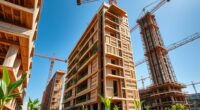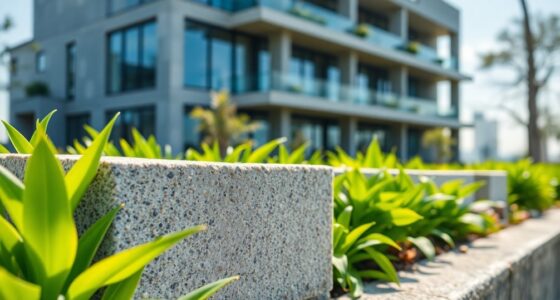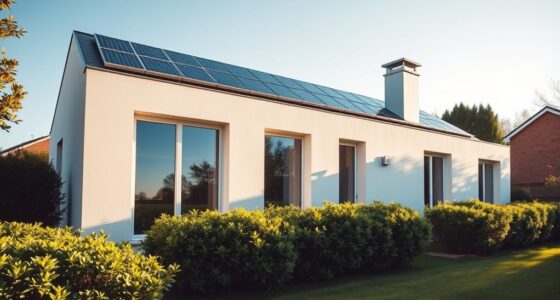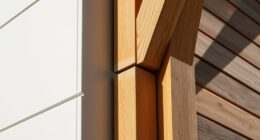Retrofitting older buildings allows you to enhance energy efficiency while preserving their historic charm. You can upgrade insulation, windows, and heating systems carefully to maintain architectural integrity. Integrating modern HVAC and renewable energy sources like solar panels can boost sustainability without compromising aesthetics. Working with specialists guarantees compliance with regulations and protects your property’s character. By making these thoughtful upgrades, you’ll create a greener, more efficient home that respects its heritage—discover more ways to blend old and new.
Key Takeaways
- Conduct thorough assessments to identify energy inefficiencies and plan targeted upgrades that preserve historic features.
- Integrate modern, energy-efficient systems like HVAC, smart thermostats, and renewable energy sources while maintaining architectural integrity.
- Use innovative insulation, sealed windows, and façade improvements to enhance thermal performance without compromising aesthetics.
- Collaborate with preservation specialists to ensure compliance with regulations and uphold the building’s historic authenticity.
- Achieve sustainability goals by revitalizing historic homes into eco-friendly, energy-efficient properties that respect their heritage.
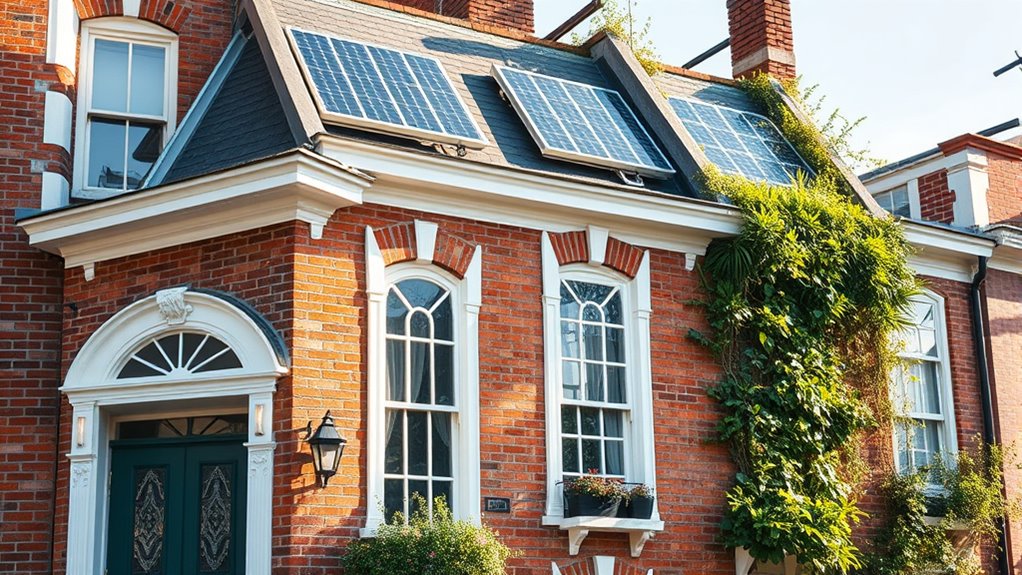
Have you ever wondered how to preserve the charm of older buildings while making them more energy-efficient and sustainable? This is where retrofitting older buildings becomes essential. It’s a delicate balance—maintaining the historic preservation that gives these structures their unique character while upgrading them to meet modern energy efficiency standards. The goal is to respect the original architecture, using innovative techniques that don’t compromise the building’s heritage. When you approach retrofitting with this mindset, you’re not just improving energy performance; you’re safeguarding a piece of history for future generations.
Retrofitting preserves historic charm while enhancing energy efficiency for future generations.
One of the first steps is evaluating the building’s current energy use and identifying areas where efficiency can be improved. Older buildings often have outdated insulation, windows, and heating systems that lead to unnecessary energy loss. By upgrading these components, you can considerably reduce energy consumption without altering the building’s aesthetic. For example, installing high-performance, historically sensitive windows helps prevent heat transfer while preserving the original look. Similarly, adding insulation in concealed spaces can improve thermal performance without damaging visible surfaces, maintaining the building’s historic integrity. Understanding the building’s construction techniques is crucial for choosing appropriate upgrades. Incorporating vertical storage solutions can also optimize space and reduce clutter, which is especially helpful in smaller historic structures. In addition, understanding the building’s energy systems allows for better integration of new technologies that enhance efficiency without invasive modifications. Additionally, advances in building insulation materials can further improve thermal performance without compromising aesthetic features.
When it comes to HVAC systems, modern, energy-efficient options are available that blend seamlessly into older structures. You don’t need to replace the entire system; instead, upgrading to smart, programmable thermostats or high-efficiency boilers can make a big difference in reducing energy costs and emissions. Energy efficiency also involves integrating renewable energy sources, like solar panels, in a way that respects the building’s character. For instance, installing solar panels on non-visible roof sections or designing custom mounts that blend into the architecture keeps the historic appearance intact.
Retrofitting isn’t only about adding new tech; it also involves careful planning and understanding the building’s original construction. Techniques like façade insulation, sealed windows, and energy-efficient lighting can all contribute to a greener, more sustainable structure. It’s important to work with specialists who understand historic preservation guidelines to guarantee upgrades comply with local regulations and don’t compromise the building’s authenticity. This collaborative approach ensures you’re enhancing energy efficiency while honoring the building’s heritage. Additionally, incorporating Vetted electric bike conversion kits can promote sustainable transportation options for occupants or visitors, reducing overall carbon footprint. Such innovative solutions demonstrate how modern technology can be harmoniously integrated into historic settings.
Ultimately, retrofitting older buildings is a rewarding process that allows you to breathe new life into historic properties. By focusing on energy efficiency and respecting the original design, you can create spaces that are both beautiful and sustainable. It’s about blending the past with the future—preserving history while embracing smarter, greener solutions. With careful planning and the right expertise, you can turn a beloved historic building into a model of sustainability that stands the test of time.
Frequently Asked Questions
What Are the Cost Implications of Retrofitting Historic Homes?
When considering retrofitting historic homes, you should conduct a thorough cost analysis to understand potential expenses. While initial costs can be higher due to specialized materials and preservation requirements, long-term savings on energy bills may offset these. Accurate budget planning helps you allocate funds effectively and prioritize upgrades. Keep in mind that costs vary based on the home’s condition and retrofit scope, so careful planning ensures you make sustainable choices without overspending.
How Do Retrofits Impact the Building’S Historical Integrity?
You might worry that retrofitting compromises architectural preservation, but when done thoughtfully, it enhances rather than erodes aesthetic authenticity. Carefully selecting sustainable materials and modern systems allows you to upgrade the building’s efficiency while respecting its historic details. This delicate balance preserves the charm that defines the home’s character, proving that environmental improvements and architectural integrity can coexist, creating a future where tradition and innovation flourish side by side.
Are There Government Incentives for Green Retrofitting Projects?
You should know that many government incentives exist for green retrofitting projects. Tax credits can substantially reduce your costs, and grant programs are available to support sustainable upgrades. These incentives aim to encourage energy efficiency and environmental responsibility. By taking advantage of them, you not only preserve your historic home’s charm but also contribute to a greener future. Make sure to research local and federal programs to maximize your benefits.
What Are Common Challenges Faced During Retrofitting?
The challenges you face during retrofitting can feel like steering a maze of obstacles. Structural reinforcement is essential, guaranteeing the building can support new systems without risking collapse. Material compatibility also poses a problem, as old materials may not work well with modern upgrades, risking damage or failure. Balancing preservation with necessary updates demands careful planning, skill, and patience to make sure the historic charm remains intact while enhancing energy efficiency.
How Long Does a Typical Retrofitting Project Take?
The retrofitting timeline varies based on the project’s scope, but typically, it takes several months to over a year. You’ll want to plan for initial assessments, design, obtaining permits, and construction. The project duration depends on factors like building size, existing conditions, and retrofitting complexity. Expect some delays, but with clear planning, your retrofit can stay on schedule, ensuring a smoother process and successful green upgrade.
Conclusion
By retrofitting your historic home, you’re blending the charm of the past with the innovation of today. It’s like giving an old friend a fresh new outfit—preserving their character while making them more comfortable and eco-friendly. While the process may seem intimidating, the result is a beautiful balance of history and sustainability. Embrace the challenge, and you’ll create a space that’s not only timeless but also kind to the planet.

